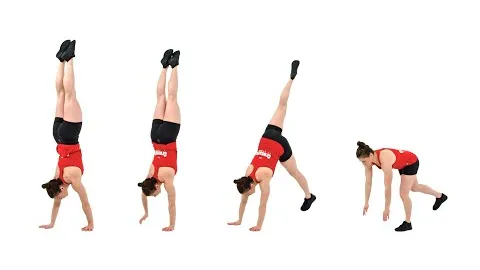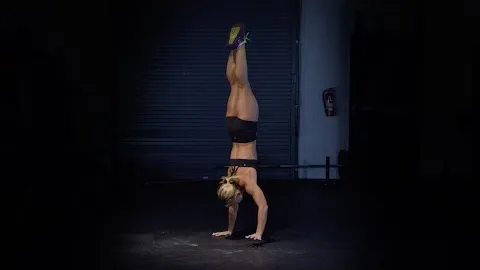

Handstand Walk Exercise: Mastering the Art of Balance and Strength
The handstand walk exercise has gained popularity in recent years as an effective way to improve balance, develop core strength, and enhance overall body control. This challenging yet rewarding movement requires proper technique, strength, and focus. In this article, we will explore the benefits of handstand walking, provide a step-by-step guide on how to perform this exercise, and offer tips to help you progress and reach your goals.
A handstand walk is a bodyweight exercise that involves moving on your hands while maintaining a fully extended inverted position. Unlike a traditional handstand, where you hold a stationary position, handstand walking requires you to move forward or backward by walking on your hands. This exercise primarily targets your upper body, particularly your shoulders, arms, and core muscles.
Handstand walking offers a wide range of benefits that go beyond just building strength and balance. Here are some key advantages of incorporating this exercise into your fitness routine:
Core Strength: Handstand walking engages your core muscles, including your abdominals, obliques, and lower back, to maintain stability and control throughout the movement. Over time, this can lead to a stronger and more resilient core.
Upper Body Development: This exercise heavily targets your shoulders, arms, and upper back. By consistently practicing handstand walking, you can enhance muscle definition, increase upper body strength, and improve overall upper body functionality.
Improved Balance and Coordination: Handstand walking requires an exceptional sense of balance and coordination. By regularly challenging your balance through this exercise, you can improve your proprioception and overall body control.
Increased Flexibility: Maintaining a proper handstand walk position requires a certain level of flexibility in your shoulders, wrists, and hamstrings. Regular practice can gradually increase your flexibility in these areas, leading to improved mobility and joint health.
Mental Focus and Concentration: Performing a handstand walk demands focus and concentration. It challenges your mental stamina and forces you to stay present, helping to improve your mind-body connection.
To begin practicing handstand walking, follow these step-by-step instructions:
Master the Basics: Before attempting a full handstand walk, ensure you have a solid foundation in the fundamental components of a handstand. Start by practicing regular handstands against a wall to develop strength and balance.
Find an Open Space: Choose a spacious area with enough room for you to move forward or backward without any obstacles.
Kick Up into a Handstand Position: Start by placing your hands on the ground shoulder-width apart and kicking your legs up into a handstand position against a wall. Focus on stacking your shoulders over your wrists, keeping your core engaged, and maintaining a straight line from your wrists to your hips.
Find Your Balance: Stay in this position for a few seconds while focusing on finding your balance. Keep your gaze fixed between your hands, and distribute your weight evenly between your hands and fingers.
Master the Weight Shift: Once you are comfortable with holding a static handstand against the wall, it's time to practice the weight shift. Slowly begin shifting your weight from one hand to the other, taking small steps with your hands as you transfer your weight.
Initiate Forward Movement: As you continue to shift your weight from side to side, gradually increase the distance between your hands while maintaining control. Focus on keeping your body tight and engaged.
Practice Controlled Steps: Take short, controlled steps with your hands, gradually walking forward or backward while maintaining your balance. Keep your movements slow and deliberate, focusing on control rather than speed.
Build Incrementally: Start with small distances and increase the length of your handstand walks as you gain confidence and strength. Remember to take breaks when needed and listen to your body.
To progress in your handstand walking journey, keep the following tips in mind:
Consistency is Key: Regularly incorporate handstand walks into your training routine to build strength and improve your balance. Aim to practice at least three times a week, gradually increasing the duration and distance as you progress.
Focus on Form: Pay attention to your form and technique throughout the movement. Maintain straight arms, engage your core, and keep your body tight and aligned. Good form will not only maximize the benefits but also minimize the risk of injury.
Work on Shoulder and Wrist Mobility: Include exercises that target shoulder and wrist mobility in your warm-up routine. This will help prevent injuries and improve your ability to maintain a stable handstand position.
Utilize Progressions: If you're not yet able to perform a full handstand walk, incorporate progressions into your training. These can include exercises like wall walks, crab walks, and pike holds to build strength and confidence.
Seek Professional Guidance: If you're new to handstand walking or you want to improve your technique, consider working with a qualified coach or trainer. They can provide personalized feedback and guidance to help you reach your goals more effectively.
Handstand walking is a challenging yet rewarding exercise that offers numerous physical and mental benefits. By incorporating this movement into your fitness routine and following proper technique and progression, you can enhance your balance, core strength, upper body development, and overall body control. Remember to start with the basics, practice consistently, and prioritize safety in your training. With time and dedication, you'll become comfortable and confident in mastering the art of handstand walking.
If you're looking for a gym, fitness club or yoga studio, you've come to the right place.
You can find information about gyms in your area. Browse catalog of gyms and find gyms with classes which are you looking for.
On gym page you can find simple information like address, phone or website. You can find list of available classes. You can check availability of personal training or small group classes. On place page you can also see information about open hours.
You can find gyms near you with amenities, courts, studios and equipments.
Use our map to find gym at your city or district.
In Gym Navigator you can find list of exercises with movies for many body parts.
You can browse exercises catalog and find exercises the best of you.
You can also find exercises grouped into workout plans, which you can use to improve you body. Each routine show you exercises one by one and give you possibility to count you progress and count down rest time.